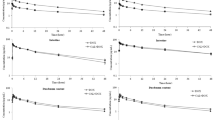Abstract
Purpose
The pharmacokinetics and bioavailability of monoHER, a promising protector against doxorubicin-induced cardiotoxicity, were determined after different routes of administration.
Methods
Mice were treated with 500 mg.kg−1 monoHER intraperitoneally (i.p.), subcutaneously (s.c.) or intravenously (i.v.) or with 1000 mg.kg−1 orally. Heart tissue and plasma were collected 24 h after administration. In addition liver and kidney tissues were collected after s.c. administration. The levels of monoHER were measured by HPLC with electrochemical detection.
Results
After i.v. administration the AUC0–120 min values of monoHER in plasma and heart tissue were 20.5±5.3 μmol.min.ml−1 and 4.9±1.3 μmol.min.g−1 wet tissue, respectively. After i.p. administration, a mean peak plasma concentration of about 130 μM monoHER was maintained from 5 to 15 min after administration. The AUC0–120 min values of monoHER were 6.1±1.1 μmol.min.ml−1 and 1.6±0.4 μmol.min.g−1 wet tissue in plasma and heart tissue, respectively. After s.c. administration, monoHER levels in plasma reached a maximum (about 230 μM) between 10 and 20 min after administration. The AUC0–120 min values of monoHER in plasma, heart, liver and kidney tissues were 8.0±0.6 μmol.min.ml−1, 2.0±0.1, 22.4±2.0 and 20.5±5.7 μmol.min.g−1, respectively. The i.p. and s.c. bioavailabilities were about 30% and 40%, respectively. After oral administration, monoHER could not be detected in plasma, indicating that monoHER had a very poor oral bioavailability.
Conclusions
MonoHER was amply taken up by the drug elimination organs liver and kidney and less by the target organ heart. Under cardioprotective conditions (500 mg/kg, i.p.), the Cmax was 131 μM and the AUC∞ was 6.3 μM.min. These values will be considered endpoints for the clinical phase I study of monoHER.


Similar content being viewed by others
References
Van Acker SABE, Towart R, Husken BCP, De Jong J, Van der Vijgh WJF, Bast A (1993) The protective effect of Venoruton and its main constituents on acute doxorubicin-induced cardiotoxicity. Phlebology Suppl 1:31
Haenen GRMM, Jansen FP, Bast A (1993) The antioxidant properties of O-(β-hydroxyethyl)-rutosides of the flavonoid mixture Venoruton. Phlebology Suppl 1:10
Van Acker SABE, Boven E, Kuiper K, Van den Berg D, Grimbergen JA, Kramer A, Bast A, Van der Vijgh WJF (1997) Monohyroxyethylrutoside, a dose dependent cardioprotective agent, does not affect the antitumor activity of doxorubicin. Clin Cancer Res 3:1747
Van Acker FA, Van Acker SA, Kramer K, Haenen GRMM, Bast A, Van der Vijgh WJF (2000) MonoHER protects against chronic doxorubicin-induced cardiotoxicity when administered only once per week. Clin Cancer Res 6:1337
Van Acker SABE, Van den Berg D, Tromp MNJL, Griffioen DH, Van Bennekom WP, Van der Vijgh WJF, Bast A (1996) Structural aspects of the antioxidant activity of flavonoids. Free Radic Biol Med 20:331
Van Acker SABE, Van Balen GP, Van den Berg D, Bast A, Van der Vijgh WJF (1998) Influence of iron chelation on the antioxidant activity of flavonoids. Biochem Pharmacol 56:935
Barrow A, Griffiths LA (1974) Metabolism of the hydroxyethylrutosides III. The fate of orally administered hydroxyethylrutosides in laboratory animals; metabolism by rat intestinal microflora in vitro. Xenobiotica 4:743
Barrow A, Griffiths LA (1974) Metabolism of the hydroxyethylrutosides II. Excretion and metabolism of 3′,4′,7-Tri-O-(β-hydroxyethyl) rutoside and related compounds in laboratory animals after parenteral administration. Xenobiotica 4:1
Barrow A, Griffiths LA (1972) Metabolism of the hydroxyethylrutosides biliary and urinary excretion of 3′,4′,4-[hydroxyethyl-14C], 7-tetra-O-(β-hydroxyethyl)-rutoside in rats and monkeys after parenteral administration. Xenobiotica 2:575
Hollman PCH, van Trijp JMP, Mengerlers MJB, de Vries JHM, Katan MB (1997) Bioavailability of the dietary antioxidant flavonol quercetin in man. Cancer Lett 114:139
Griffiths LA, Barrow A (1972) The fate of orally and parenterally administered flavonoids in the mammals. Angiologica 9:162
Manach C, Morand C, Texier O, Favier M, Agullo G, Demigne C, Regerat F, Remesy C (1995) Quercetin metabolites in plasma of rats fed diets containing rutin or quercetin. J Nutr 125:1911
Griffiths LA, Hackett AM (1978) Hepatic clearance and disposition of hydroxyethylated rutosides. Arch Toxicol Suppl 1:243
Abou El Hassan MAI, Kedde MA, Bast A, Van der Vijgh WJF (2001) High performance liquid chromatography with electrochemical detection for the determination of 7-monohydroxyethylrutoside (monoHER) in plasma. J Chromatogr B 752:115
Abou El Hassan MAI, Kedde MA, Bast A, Van der Vijgh WJF (2001) Determination of monohydroxyethylrutoside (monoHER) in heart tissue by HPLC with electrochemical detection. J Chromatogr B 757:191
UKCCCR (1988) Guidelines for the welfare of animals in experimental neoplasia. Br J Cancer 58:109
Wienert V, Gahlen W (1970) Renal excretion of trihydroxyethyl rutoside (Venoruton) after parenteral and oral administration. Hautarzt 21:278
Ader P, Wessmann A, Wolffram S (2000) Bioavailability and metabolism of the flavonol quercetin in the pig. Free Radic Biol Med 28:1056
Korst AEC, Boven E, Van der Sterre MLT, Fichtinger-Schepman AMJ, Van der Vijgh WJF (1998) Pharmacokinetics of cisplatin with and without amifostine in tumor-bearing nude mice. Eur J Cancer 34:412
Hackett AM, Griffiths LA (1977) The disposition and metabolism of 3′,4′,7-Tri-O-(β-hydroxyethyl) rutoside and 7-mono-O-(β-hydroxyethyl) rutoside in the mouse. Xenobiotica 7:641
Hackett AM, Griffiths LA (1979) The metabolism and excretion of 7-O-(β-hydroxyethyl)-rutoside in the dog. Eur J Drug Metab Pharmacokinet 4:207
Ekestroem S, Welti R (1990) The affinity of hydroxyethylrutosides for the venous wall and its efficacy in preventing early occlusions of aorta-coronary vein bypass graft. Phlebology 5 [Suppl 1]:41
Neumann HAM, Carlsson K, Brom GH (1992) Uptake and Localization of O-(β-hydroxyethyl) rutosides in the venous wall, measured by laser scanning microscopy. Eur J Clin Pharmacol 43:423
Abou El Hassan MAI, Touw D, Wilhelm A, Bast A, Van der Vijgh WJF (2000) Stability of monoHER in an aqueous formulation for i.v. administration. Int J Pharm 211:51
Author information
Authors and Affiliations
Rights and permissions
About this article
Cite this article
Abou El Hassan, M.A.I., Kedde, M.A., Zwiers, U.T.H. et al. Bioavailability and pharmacokinetics of the cardioprotecting flavonoid 7-monohydroxyethylrutoside in mice. Cancer Chemother Pharmacol 52, 371–376 (2003). https://doi.org/10.1007/s00280-003-0667-z
Received:
Accepted:
Published:
Issue Date:
DOI: https://doi.org/10.1007/s00280-003-0667-z




